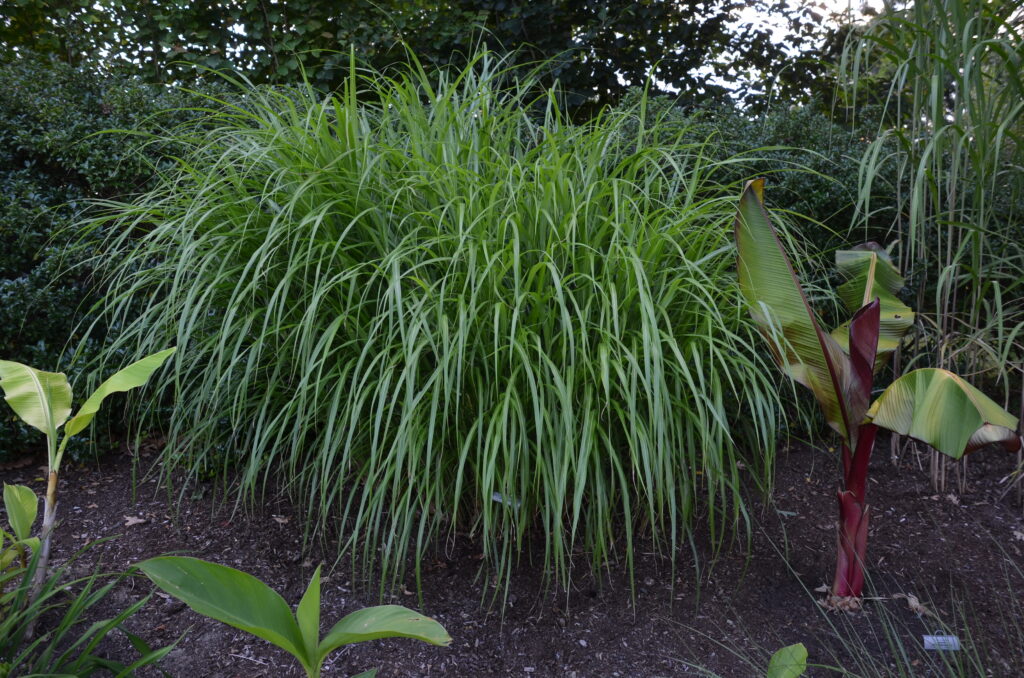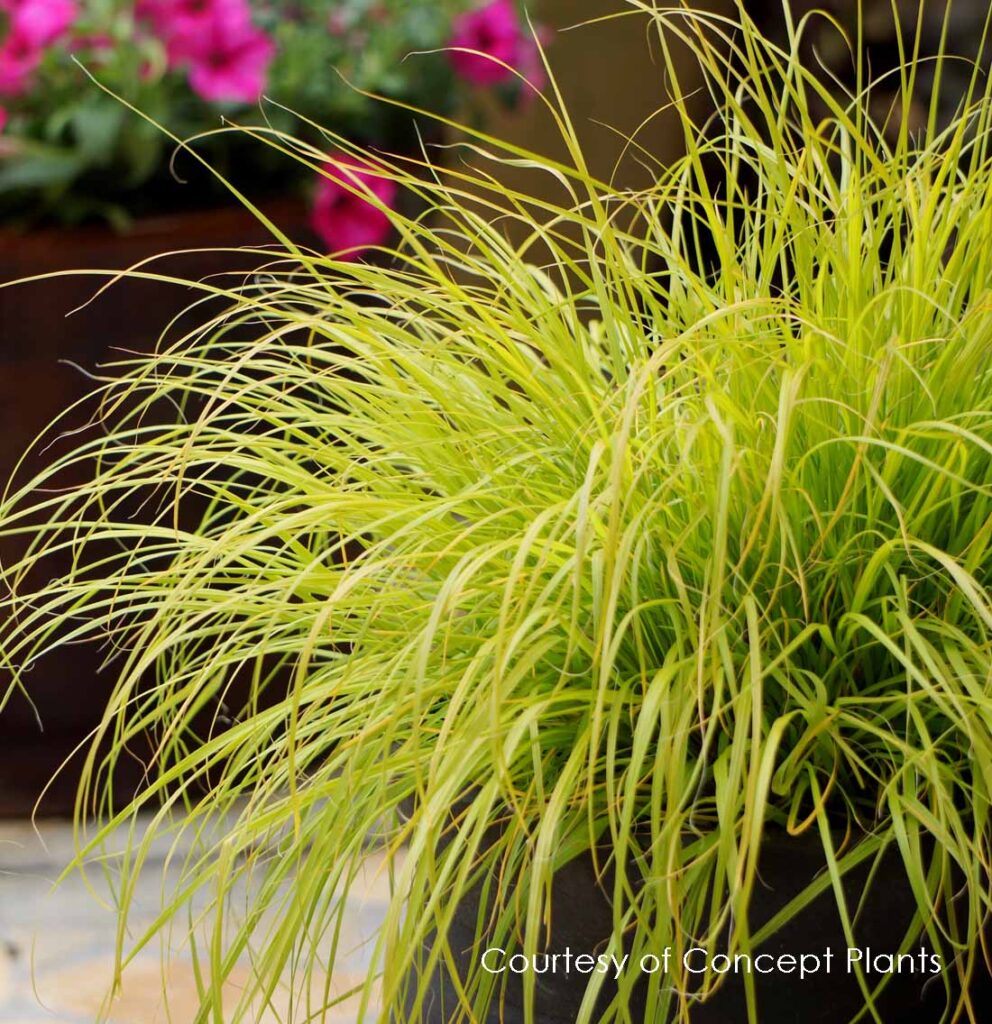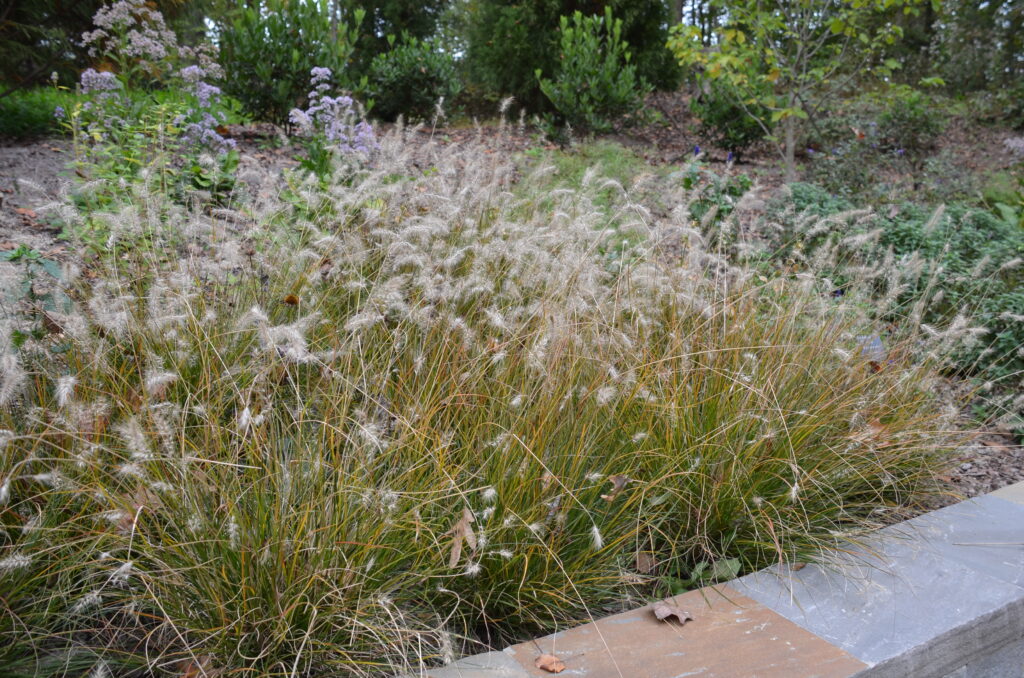
Fountain grasses (P. alopecuroides) are perennial warm season grasses that are native to meadows and open woods of Eastern Asia (mainly China and Japan) and Western Australia. Cultivars hardiness ranges from zone 4 (5) – 10. These ornamental grasses have finely textured deep green foliage and elegant form. Leaves and flower spikes sway in the breeze, adding movement to the landscape.
Fountain grasses grow 12 – 48 inches tall, depending on the cultivar. Growth is upright at first, then the leaf blades arch downward at maturity, resembling a flowing fountain. The length and width of the long, tapering, subtly serrated blades vary greatly among cultivars. Leaves turn orange-bronze in autumn, eventually turning to a dull beige color, and offers late fall interest. Inflorescences do not persist as a snowy winter begins.
Fountain grass flower spikes are fuzzy-looking, bottle-brush-like inflorescences (inflorescences). In late summer showy, white to pink, copper or purple flower spikes emerge above the leaves. They’re particularly dramatic when backlit by the sun behind them. The inflorescences also do not last because seed heads begin to shatter after a few hard freezes in autumn.
Fountain grass is easily grown in most soils and performs best in full sun. It prefers moist, well-drained soils, but becomes drought tolerant once established. Plant the grass with the crown of the plant above ground level to avoid crown rot, especially in moist soils. Plantings may decline in very wet years or poorly drained soils. During dry periods, leaf blade tips may turn brown if not watered. Fountain grasses have few pest problems and are considered deer resistant.
As a warm season perennial grass, it doesn’t start growing until the ground has warmed up. Trim the grass to 3-6 inches above the ground before the new spring shoots appear. Every 3-5 years, depending on the vigor of the variety, divide and replant after shearing to rejuvenate clumps.
Use fountain grass as a specimen plant or as a focal point in smaller areas. In bigger gardens, use plants individually or in small groups with perennials and shrubs to provide a contrast of texture or massed in large groups as a tall ground cover. Early in the season fountain grasses do not stand out but their showy inflorescences offer a soft, fine texture and movement in a breeze.
Many varieties may self-seed readily (to the point of being weedy). Many do not always come true from seed. Remove seed heads before they shatter (burst open) if self-sowing is a concern. In colder climates this species never becomes invasive like it can in warmer areas. They look lovely coated in frost and dusted with snow.

Cultivars
- ‘Cassian’ has cream green tinted bottlebrush blooms turning a rich golden fall color with orange-red tints in fall; it grows about a foot taller than ‘Hameln’ in the South and is coarser textured. (Z 5/6-9).
- ‘Fox Trot’ grows much taller, with more rosy- or black-colored inflorescences. is an impressive ornamental grass with its 4-foot fountain shape of narrow, green foliage. In midsummer, stalks topped with four-inch, pink-tinted bottlebrush seedheads appear. The slightest breeze causes elegant movement (hardy to zone 4).
- ‘Hameln’ grows compact than the species (18-24 inches tall and wide), with bright green foliage and silvery-white flowers that bloom about 2 weeks earlier than the species. It does not reseed prolifically. (Z 5-9).
- ‘Little Bunny’ is a super dwarf form only 8 to 18 inches high and a spread of 10 to 15 inches; light cream-colored inflorescences appear 2 months earlier than species; russet golden color in fall. (Z 5-9).
- ‘Lumen Gold’ has globe-shape habit and bright golden foliage in spring, turning lemon in early summer, and light green by late summer. Grows 2.0 inches tall Plumes 6-12″ tall. (Z 6-9)
- ‘Moudry’ (P. alopecuroides var. viridescens), called “black fountain grass”, produces deep maroon upright inflorescences in late summer; mounding form, grows 2½ -3 feet tall and wide, with wide leaves. Blooms in late summer the flower heads mature a blackish purple color against golden yellow fall color. (Z 5b-9).
- ‘Piglet’ produces white (pink-tinged) inflorescence; dwarf only 1.5 inches tall (Z 5-9).
- ‘Red Head’ forms a large mound of arching green leaves. Soft smoky-pink colored, 8-inch bottlebrush flower spikes appear in mid to late summer, turning to buff as they dry. Begins flowering early; stays attractive well into the winter. (Z 5-9).


 Posted in
Posted in 
